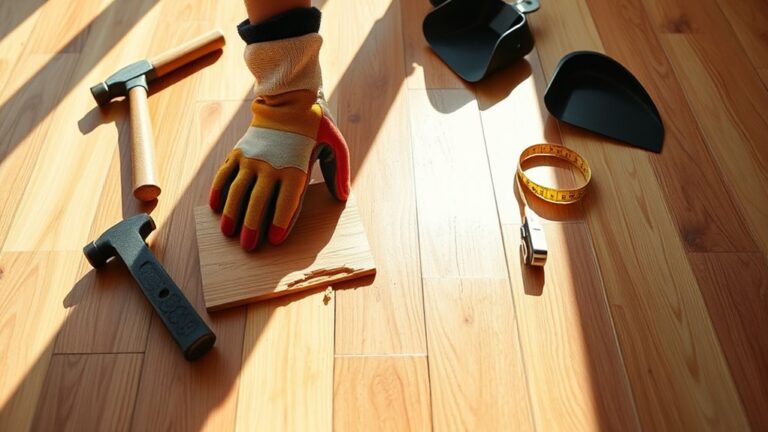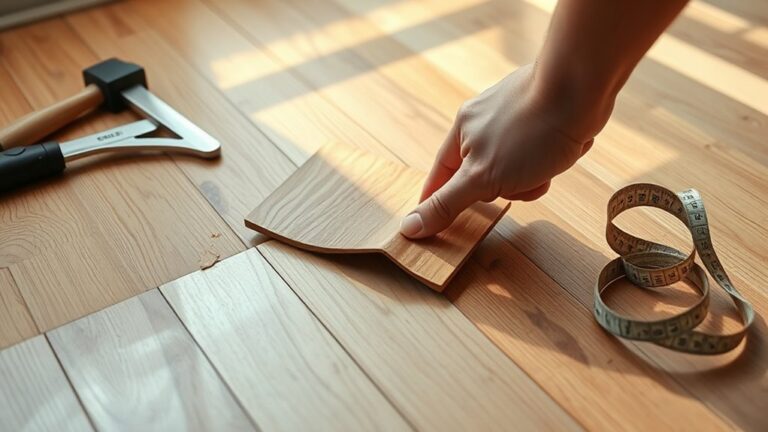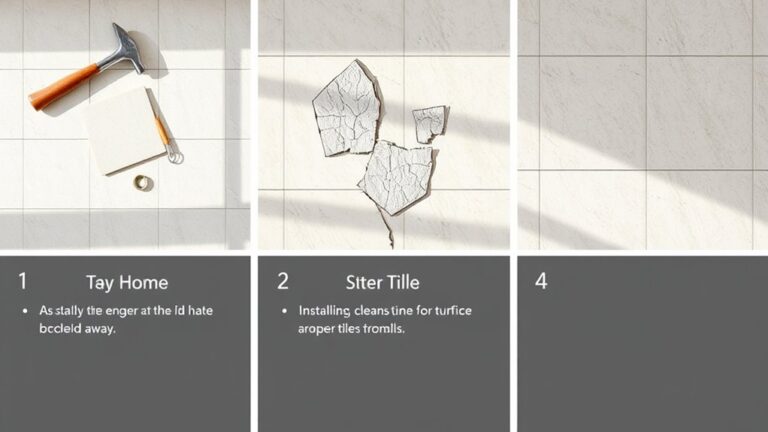To avoid acid damage on your marble floors, prioritize proper maintenance and cleaning. Use pH-neutral cleaners, as acidic substances like vinegar or lemon juice can etch the surface. Always clean up spills immediately, particularly if they're acidic. Regularly seal your marble every 6-12 months to provide a protective barrier against stains. Additionally, place mats in high-traffic areas to reduce wear and prevent scratches. Handle heavy items with care to avoid cracks, and always use soft mops for cleaning. Keeping these tips in mind will help maintain the beauty of your marble floors. You might find additional insights beneficial.
Understanding Marble Stone
Marble, a striking metamorphic rock, is primarily composed of calcium carbonate and is formed from limestone under heat and pressure. This unique composition gives marble its renowned aesthetic appeal, showcasing various colors and distinctive patterns that elevate the visual quality of any space. However, marble's beauty comes with inherent vulnerabilities, particularly its susceptibility to acidic substances.
As a porous material, marble easily absorbs liquids, which can lead to staining and etching if not managed properly. When acidic cleaning products or spills, such as lemon juice or vinegar, come into contact with marble surfaces, they can react with the calcium carbonate, causing damage that diminishes its luster. It's essential to be aware that even common cleaning products can contain acidic components that may harm your marble.
Understanding marble's characteristics is significant for maintaining its elegance. Regular maintenance, including sealing the surface, is crucial to reduce its porosity and enhance its resistance to stains. You'll also want to use pH-balanced cleaners specifically designed for marble to avoid any adverse reactions. These products help preserve the integrity of the stone while ensuring it remains clean and visually appealing.
Types of Damage to Marble
Due to its porous nature, marble can be easily damaged by various factors, resulting in both aesthetic and structural issues. One of the primary concerns is the impact of acidic substances, such as lemon juice or vinegar, which can lead to irreversible etching on marble floors. This etching dulls the finish and may require professional restoration if severe.
Another common type of damage includes stains, which often occur when spills aren't promptly cleaned up. If acidic cleaning solutions are used, they can exacerbate these issues, causing permanent discoloration. Additionally, cracks can develop from heavy impacts or poor-quality marble, compromising the integrity of your floors.
Scratches are also prevalent, often resulting from the movement of heavy furniture or contact with abrasive materials. It's essential to be mindful of how items are placed on your marble floors to minimize this risk. Prolonged exposure to heat can aggravate cracking, so take care when situating heat-generating items.
Regular maintenance is fundamental in preventing these types of damage. Sealing your marble floors can provide a protective barrier, while immediate cleanup of spills can help avoid long-term staining. Understanding these various types of damage is critical to maintaining the beauty and durability of your marble surfaces, ensuring they remain a stunning feature in your space for years to come.
Preventing Stains and Etching
Maintaining the pristine appearance of marble floors requires vigilance against stains and etching, which can arise from everyday activities. To effectively protect your stone, one of the first steps is to avoid using acidic cleaners during your cleaning marble routine. These substances can cause irreversible damage and dull the finish, making your beautiful floors less appealing.
Immediate cleanup of spills is vital, especially for acidic substances like lemon juice or coffee. Marble's porous nature allows these liquids to be absorbed quickly, leading to potential staining and etching. It's advisable to have absorbent cloths handy to address any accidents promptly.
In addition to quick spill management, regular dusting will help you prevent stains by keeping dirt and debris from embedding into the marble surface. By reducing the risk of scratches, you maintain the floor's integrity and beauty.
Sealing your marble surfaces every 6-12 months is another essential practice to protect against stains and etching. This sealing process creates a barrier that enhances durability and prolongs the marble's aesthetic appeal.
Lastly, utilizing mats and rugs in high-traffic areas can markedly reduce wear and tear, preventing dirt from being tracked onto your marble floors. By implementing these strategies, you can effectively prevent stains and etching, ensuring your marble floors remain stunning for years to come.
Protecting Against Cracks and Scratches
Protecting against cracks and scratches on marble floors is essential for preserving their elegance and structural integrity. To maintain your marble surfaces and prevent any potential damage, consider implementing the following measures:
- Avoid dragging or dropping heavy items on your marble floors. This can lead to chips and considerable structural damage, undermining the beauty of your investment.
- Use furniture with rubber feet. This simple adjustment can greatly reduce the risk of scratches and dents, ensuring your marble surfaces remain pristine.
- Inspect high-traffic areas regularly for signs of wear. Early detection of potential damage allows for timely interventions, preventing further deterioration of your marble floors.
- Choose soft cotton mops for cleaning. Avoid abrasive materials that can scratch the marble finish, as these can also contribute to long-term damage.
In addition to these strategies, placing rugs or mats in high-traffic areas can help absorb impact and reduce wear and tear. Remember that acidic cleaners can further damage your marble, so always opt for pH-neutral alternatives when cleaning. By taking these precautions, you can effectively protect against cracks and scratches, ensuring your marble floors remain a stunning centerpiece in your home for years to come. With diligent care and attention, you'll maintain the beauty and integrity of your marble, allowing it to shine without the worry of damage.
Maintenance Tips for Marble Floors
After taking steps to prevent cracks and scratches on your marble floors, it's important to establish a solid maintenance routine to keep them looking their best. Regular cleaning is vital; use pH-balanced stone cleaners specifically designed for natural stone. Avoid acidic cleaners, as they can dull the surface and cause etching over time.
Make it a practice to seal your marble surfaces every 6-12 months. A high-quality sealer, like Granite Gold Sealer®, creates a protective barrier against stains and acid damage, ensuring your marble floor remains pristine. Spills, especially from acidic substances like citrus juices and vinegar, should be cleaned up immediately to prevent permanent staining or etching.
For effective cleaning, opt for soft cotton mops. They're ideal for maintaining the integrity of your marble, as abrasive materials can scratch the surface. Regular dusting is also essential to prevent debris buildup, which can lead to scratches.
Additionally, consider placing entryway mats and rugs in high-traffic areas. These will help catch dirt and moisture, greatly reducing the risk of scratches and maintaining the marble's overall condition.
Recommended Products for Care
To effectively care for your marble floors, using specialized cleaning solutions is essential. Consider high-quality stain removal techniques and protective treatments to safeguard against acid damage. Selecting the right products will not only maintain the marble's appearance but also extend its lifespan.
Essential Cleaning Solutions
Maintaining the beauty of your marble floors requires the right cleaning solutions that won't compromise their integrity. pH-neutral cleaners like MC24 Daily Stone Cleaner are specially designed for this purpose, ensuring that your marble surfaces remain free from acid damage and etching. Here are some essential cleaning solutions you should consider:
- MC24 Daily Stone Cleaner: A reliable pH-neutral cleaner that protects against acid damage.
- Granite Gold Daily Cleaner®: This product not only cleans effectively but also maintains your marble's natural finish, protecting it from acidic substances.
- 314P Premium Sealer: Regular sealing every 6-12 months can provide an essential barrier against stains and acid penetration.
- Specialized Poultice Products: Ideal for tackling existing stains caused by acidic spills, helping to restore your marble's original beauty.
Effective Stain Removal Techniques
When it comes to preserving the elegance of your marble floors, effective stain removal techniques are essential. You can use hydrogen peroxide and bleach to treat etch spots, but always test these chemicals on a small area first to avoid further damage. For stubborn stains, consider a gentle alternative like baking soda mixed with water.
The paper towel method, where you apply soaked towels to the stained area for an extended period, can help lift tough stains effectively. Additionally, specialized marble cleaning solutions, such as Granite Gold Daily Cleaner®, are recommended for regular maintenance to prevent harsh chemical damage.
Here's a quick reference table to help you choose the right stain removal method:
| Stain Type | Recommended Solution | Notes |
|---|---|---|
| Etch Spots | Hydrogen Peroxide or Bleach | Test on a small area first |
| Oil/Organic Stains | Poultice | May need resealing afterward |
| Stubborn Stains | Baking Soda Paste | Gentle on marble |
| Regular Maintenance | Granite Gold Daily Cleaner® | Safe for frequent use |
Recommended Protective Treatments
Effective stain removal techniques serve as a foundation for maintaining the integrity of your marble floors, but protective treatments play an essential role in long-term preservation. To guarantee your marble remains pristine, consider integrating the following products into your care routine:
- High-Quality Sealer: Apply a sealer like Granite Gold Sealer® every 6-12 months. This creates a barrier against liquid penetration, protecting against acid damage and stains.
- pH-Neutral Cleaners: Use cleaners such as MC24 Daily Stone Cleaner. These guarantee your marble is cleaned effectively without risking acid damage from traditional products.
- Anti-Acid Etch Treatments: These treatments provide an additional layer, preventing acidic substances from causing irreversible damage to your marble.
- Marble Refinishing Kit: Invest in honing and polishing tools to periodically restore the surface's shine and protect against future acid etching and scratches.
Frequently Asked Questions
How Do You Protect Marble From Acid?
So, you wanna protect your marble from acid, huh? Well, first off, don't let your lemon juice run wild! Use marble sealants to create a protective barrier, and make sure to have pH-neutral cleaning products on hand for surface maintenance. Preventative measures like coasters under drinks and cutting boards for food prep can save you from future headaches. Remember, a little care goes a long way in keeping your marble pristine!
How to Get Rid of Acid Marks on Marble?
To get rid of acid marks on marble, start with effective cleaning techniques like honing the surface with diamond polishing solutions to remove etching. For minor marks, use a baking soda poultice to lift stains. If damage is extensive, consider professional restoration methods. Additionally, implement preventative measures by sealing your marble regularly; it'll help protect against future acid damage. Remember, immediate cleanup of spills is essential to minimize lasting effects.
Can Marble Be Damaged by Acid?
Yes, marble can definitely be damaged by acid. Think of it like a sponge soaking up trouble from acid sources like coffee or citrus. For marble care, it's essential to adopt effective cleaning tips and maintenance routines. Use pH-neutral cleaners and wipe away spills immediately to prevent dull etching. By being proactive, you can preserve your marble's beauty and keep it shining, ensuring it remains a stunning focal point in your space.
What to Do if Acid Falls on Marble Floor?
If acid falls on your marble floor, your immediate response is vital. Quickly blot the area with a soft cloth to absorb the liquid without spreading it. Avoid water; instead, use a neutral pH cleaner designed for marble. For stain prevention, apply a baking soda poultice covered with plastic wrap for several hours. After cleaning, inspect for damage, as surface restoration may require professional honing if etching or discoloration appears.




